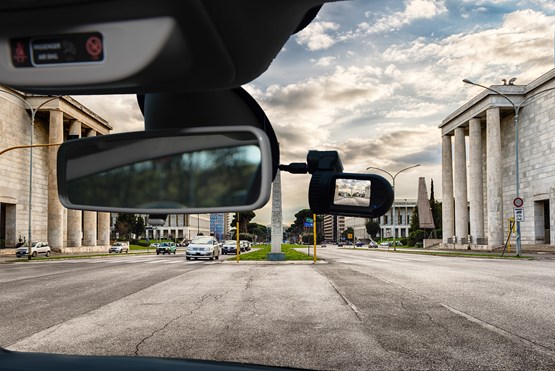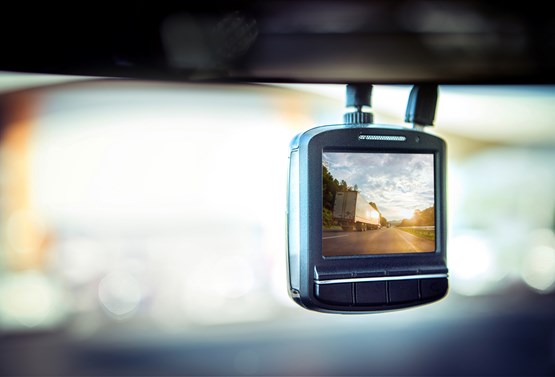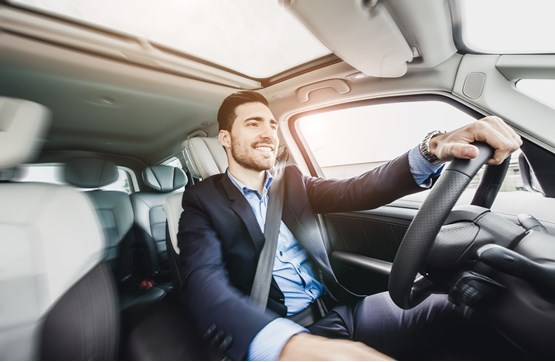Telematics can transform a fleet’s operations, but combining the technology with cameras adds another dimension. Catherine Chetwynd reports
Telematics technology has transformed the way many organisations manage their fleets. The ability to monitor driver behaviour has allowed companies to cut incident rates, slash fuel costs and plan more efficient delivery routes.
However, while the data the technology produces has proved invaluable to many organisations, it doesn’t always explain why a driver may be driving the way they do.
“Cameras complete the picture,” says Steve Thomas, managing director (sales and marketing) at Ctrack.

“Telematics gives you all the information, when the vehicle is used, its speed etc, but not footage of an event. Putting cameras into a vehicle gives the last piece of the jigsaw.”
This is important because while a ‘black box’ telematics system can provide a fleet manager with details of incidents such as harsh acceleration, braking and speeding, it doesn’t provide the context.
For this, a fleet decision-maker would usually have to debrief the driver to find out what caused the incidents: often a time-consuming process.
However, video evidence provides accurate context. What might appear to be unnecessarily sharp braking may have been in response to a child stepping out into the road.
“It gives a different aspect to the thinking,” says Andrew Tillman, marketing director at Trakm8.
READ MORE: How to make the most of telematics data
Gaining this greater understanding of what was happening on the road was a major reason why convenience foods company Greencore fitted 3G vehicle cameras to its fleet of temperature-controlled vans.
These vehicles are in its Direct to Store operation, which handles more than 7,500 daily deliveries of chilled prepared food to convenience stores nationwide.
Footage of near misses, collisions and harsh driving events are shared across a network of 17 distribution sites, which are used by each depot management team to engage directly with drivers during debriefs and performance reviews.
“The system allows us to effectively target road safety improvements through enhanced driver engagement, education and training,” says Ben Martin, head of transport and network optimisation at Greencore.
As part of its Fit for the Future programme, which is designed to further improve health and safety, sustainability and duty of care, Greencore is setting up an in-house training operation which will use the video and supporting data to support driver education initiatives and targeted coaching.

Its system uses forward-facing cameras, which are usually either installed on the front windscreen or dashboard and see what the driver is seeing.
However, some systems also use cameras which face the rear while others can look internally at what the driver is doing.
These can be particularly useful as it can let the fleet manager see if their driver was on a mobile phone, eating, or distracted in some other way while behind the wheel.
Showing drivers videos of their driving is a highly effective corrective. Iceland – a client of Trakm8 – educated their drivers by showing them footage from vehicles.
“Over about six months, the number of accidents in the business was reduced by well in excess of 30% because drivers weren’t thinking ‘I’m being watched’, they were shown poor driving behaviour and made to understand the consequences,” says Tillman.
Iceland also saw a substantial reduction in tyre usage and maintenance.
Textiles supplier Berendsen has gone a step further with its telematics camera coverage: its fleet of 720 commercial vehicles are fitted with cameras which provide 360-degree coverage.
“There are no blind spots anywhere around the vehicle,” says group transport compliance and optimisations manager Peter Kelly.
“We can either take the video away or dial into a camera, which gives an added benefit in the case of an accident, when we need to understand what position the vehicle is in and what has happened – we have not had to do that yet.”
In addition, “the best fleet drivers are the ones that understand the bad habits of other motorists and make allowances for them”, says Paul Singh, founder of SmartWitness.
“Watching and analysing past incidents often highlights these bad behaviours and how to avoid them, thereby providing the best educational aids for all staff, not just the driver involved.”
When SmartWitness launched its live video telematics service, it was trialled by three UK fleets, which saw reductions in accidents of 68%, 78% and 100% over six months.
Persistent errant behaviour can lead to training.
READ MORE: Top 10 KPI’s fleet managers should track, according to Mix Telematics
Although some fleet managers may want to train all drivers regularly, “it’s the old adage, you don’t want to be worried about the 80% that is doing everything right but to focus on the 20% that needs driver training and spend financial resources in the right places”, says Beverley Wise, sales director at TomTom.
Singh adds: “The most important benefit is safety, but others are lower insurance premiums, speedy claims procedure, eradication of bogus third-party disputes and fuel efficiency benefits.”
A gentle right foot and avoiding harsh events can also improve fuel consumption dramatically – often by as much as 30% with a corresponding reduction in emissions.
When Kelly put the proposals for the camera telematics system to the Berendsen board, he said it would probably make between a 5% and 6% improvement in fuel economy: it is currently around 12%.
Ctrack says that any savings in fuel that a company makes through improved driver behaviour can be used to further incentivise improvements.

Scores from telematics systems can be combined with league tables to promote competition among drivers.
Ctrack has customers who provide cash bonuses to the best drivers. “The schemes are self-funded, so if the company saves £100,000 a year on fuel because of good driving technique, it might divert £50,000 into driver bonuses,” says Thomas.
Proof of the success of telematics and cameras comes in the form of a driver working for a client of Ctrack.
He did not want the device telling him how to drive, but six months later, in the client company newsletter, he wrote that his wife and children had noticed he was a better driver and felt safer in a vehicle with him, and that he supported telematics.
Telematics and cameras also protect drivers from the vagaries of other road users’ behaviour and from false accusations because the cameras pick up the whole story.
They also validate who was driving at any given moment, superseding ID cards which can be given to someone else.
All of these things not only look after the driver, but protect the reputation of the company.
“The main benefit is instant notification, which leads nicely into first notification of loss (FNOL),” says Phil Powell, sales director of Matrix Telematics.
“In the event of a collision, we need to gather as much relevant information as quickly as we can.
“We get a full report from the telematics box and that is fully backed up by camera footage.
“We expect to receive a 20-second clip of footage – 15 seconds before the event and five seconds afterwards – and that allows us to ascertain whether it is a serious collision and whether further action is needed.
“That information can be passed on to the insurance company and, if more information is required, the 20 seconds can be supplemented by minute-by-minute chunks downloaded via the same portal.”
It also reduces the number of 50:50 settlements, he says.
READ MORE: Fleet managers divided on benefits of telematics - Fleet200 roundtable discussion
Speed of FNOL is increasingly important. “The average time in the UK for a claim to be processed is 29 days,” says Wise.
“After an incident has been reported, the insurance company has to complete around 34 questions for the claim and that depends on how quickly they can get hold of the driver.
“We are able to send footage and first notification of loss by email within one minute 45 seconds, allowing the insurance company and broker to complete the questions with the driver quickly, so the claim can start to be processed within three or four days.”
Video footage also obviates false claims. They were costing SmartWitness client CRH Transport Training £1,600 per week, but camera telematics cut this by 90%.
Using back-up from a live video telematics system, CRH Transport Training can check whether its driver was at fault and provide court-admissible evidence.
“In many cases they were small claims, mainly broken door mirrors, but on modern cars that would be £300-£400 each time and we had no defence against them,” says Chris Hetherington, managing director at CRH Transport Training.
“It was cheaper to pay them ourselves than to go through our insurance company but now, when we mention that we can check the video evidence for the exact time and place they are claiming for, it is amazing how these allegations disappear.”
The benefits of a combined telematics and camera system seem clear, but Wise warns that just fitting the technology is not enough.
“These technologies are great but they need managing, you can’t just put them in and expect everything to change,” she says.
“Companies that act on the data that is generated through the combined systems will ensure that employees become better drivers.
“Some of this is about how you communicate with your drivers; if you convey the starting position and advances they have made, significant improvements should be seen because they realise the benefits, then the organisation’s insurance claims will potentially be reduced, giving the best return on investment.”
Case study: Downwell Group
Downwell Group has reduced its insurance premiums by 20% and seen its incident rate fall after adopting a connected vehicle camera solution.
The provider of demolition, asbestos removal and scaffolding services had used vehicle tracking for a number of years, primarily as an insurance provision. It installed the camera system after negotiating an additional premium reduction by adopting the technology.
It installed the Intelligent Telematics IT1000 and IT2000 single- and dual-camera devices across its mixed fleet of more than 50 cars and vans last year.
Both devices use a front-facing camera mounted on the windscreen, while the IT2000 uses a second camera to capture video from inside the vehicle.
“We now have access to footage within moments of any incident, so we know exactly what has occurred, how it has happened and can positively identify who is at fault,” says Steven Padmore, operations director of Downwell Group.
“We can quickly respond to any situation and pass the necessary information straight to our insurance company, potentially avoiding spurious claims.”
READ MORE: Building the business case for telematics
All collisions, near miss and harsh driving events are automatically recorded and uploaded to a secure server network, with serious incidents triggering a text or email alert.
Downwell Group is then able to view the footage of before, during and after the accident.
This information is used to analyse driver behaviour and encourage improved driving practices by supporting targeted training, better engaging with drivers and implementing an incentive scheme.
The company hopes this will improve safety and contribute to reduced wear and tear on vehicles, lower fuel consumption and a positive brand perception.
“The vehicle cameras are already impacting driver behaviour and helping positively influence the mindset of our workforce when they are out on the road,” says Padmore.
“It is also providing added protection and support to drivers who now know that emergency services can be contacted as soon as an incident has occurred and that the video can be used to validate their version of the story.”
What technology is available?
SD card cameras have a memory stick, which has to be physically retrieved in the event of an accident or sent by the driver to the fleet manager.
This is troublesome if a driver is involved in an incident hundreds of miles from base.
3G cameras use a sim card that allows data to be relayed immediately to a fleet manager and insurance company in the event of an incident.
However, it is possible to integrate SD cameras into a telematics device, so the data is forwarded by the unit.
Intelligent Telematics has a two-camera 3G system with a second piece of equipment either in the cab or at the rear of the vehicle, linked to a monitor to act as a reversing aid and provide additional data in the event of an accident.
A four-camera system follows in April, allowing a camera on all vehicle sides, providing 360-degree coverage.
Matrix Telematics recently upgraded the 3G HD33 to the MTC33 IncidentCam, which gives the option of a second internal camera.
“We have also set up a call centre, Driive with Matrix, to look at camera footage and hold an intervention direct with the driver at a pre-determined time when a collision has occurred,” says managing director Colin Hartley.
TomTom works with two SD camera providers to cover the range of client requirements. Both integrate into the company’s Webfleet software, allowing users to retrieve data from its platform.
In October 2017, Trakm8 launched the fully integrated RH600 4G telematics camera, with single or dual cameras.
It has since added advanced driver assistance systems (ADAS), which identify risks such as using a mobile while driving, micro-sleeping or drifting between lanes, and uses algorithms to recognise patterns and sound an alarm to preclude the event.
Trakm8 will add this information to its driver behaviour scores. Intelligent Telematics is also introducing a 4G compatible device later this year.

















Login to comment
Comments
No comments have been made yet.